No CrossRef data available.
Article contents
Slavery, Emancipation, and the Civil War Transformation of the U.S. State
Published online by Cambridge University Press: 23 April 2014
Abstract
An abstract is not available for this content so a preview has been provided. Please use the Get access link above for information on how to access this content.

- Type
- Review Essays
- Information
- Copyright
- Copyright © American Political Science Association 2014
References
Farr, James. 1990. “Francis Lieber and the Interpretation of American Political Science.” Journal of Politics
52(4): 1027–49.CrossRefGoogle Scholar
Gates, Jr
Louis, Henry, ed. 2009. Lincoln on Race & Slavery. Princeton, NJ: Princeton University Press.Google Scholar
Grossman, James. 2012. “Did They Really Say That: Getting Our Quotations Right.” AHA Today: A Blog of the American Historical Association, August 20. http://blog.historians.org/2012/08/did-they-really-say-that-getting-our-quotations-right/, accessed December 1.Google Scholar
Hacker, J. David. 2011. “Recounting the Dead.” New York Times, September 11: http://opinionator.blogs.nytimes.com/2011/09/20/recounting-the-dead/#more-105317, accessed December 1.Google Scholar
Hahn, Steven. 2003. A Nation Under Our Feet: Black Political Struggles in the Rural South From Slavery to the Great Migration. Cambridge, MA: Belknap Press of Harvard University Press.Google Scholar
Higginson, Thomas Wentworth. 1900. Army Life in a Black Regiment. Cambridge, MA: Riverside Press.Google Scholar
Hofstadter, Richard. 1948. The American Political Tradition: And The Men Who Made It. New York: Alfred A. Knopf.Google Scholar
Holt, Michael F. 2002. “The Kansas–Nebraska Act.” Getting the Message Out: National Political Campaign Materials, 1840–1860. Abraham Lincoln Historical Digitization Project, Northern Illinois University Libraries. http://dig.lib.niu.edu/message/about.html, accessed December 1.Google Scholar
Jenkins, Jeffery A., and Nokken, Timothy P.. 2000. “The Institutional Origins of the Republican Party: Spatial Voting and the House Speakership Election of 1855–56.” Legislative Studies Quarterly
25(1): 101–30.Google Scholar
Luthin, Reinhard H. 1944. “Abraham Lincoln Becomes a Republican.” Political Science Quarterly
59(3): 420–38.Google Scholar
Martis, Kenneth C. 1989. The Historical Atlas of Political Parties in the United States Congress, 1789–1989. New York: Macmillan Company.Google Scholar
Poe, Edgar Allan. 1839. “The Fall of the House of Usher.”
http://xroads.virginia.edu/∼Hyper/poe/fall.html, accessed December 1.Google Scholar
Wilkerson, Isabel. 2010. The Warmth of Other Suns: The Epic Story of America’s Great Migration. New York: Random House.Google Scholar
Williamson, Samuel H. 2013. “Seven Ways to Compute the Relative Value of a U.S. Dollar Amount, 1774 to present.” At
www.measuringworth.com/uscompare/, accessed December 1.Google Scholar




